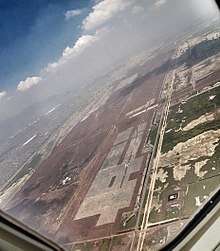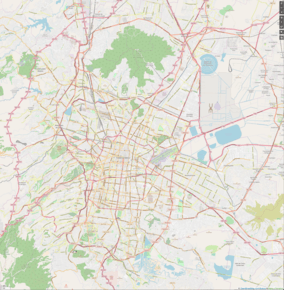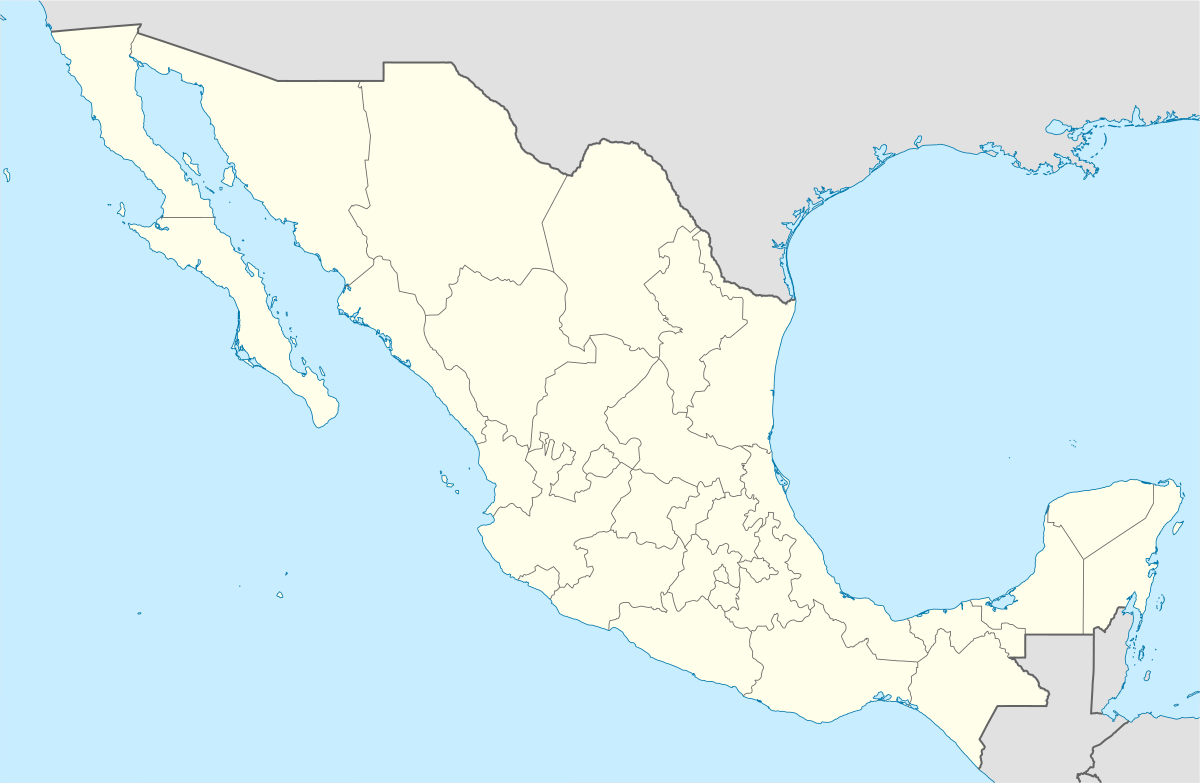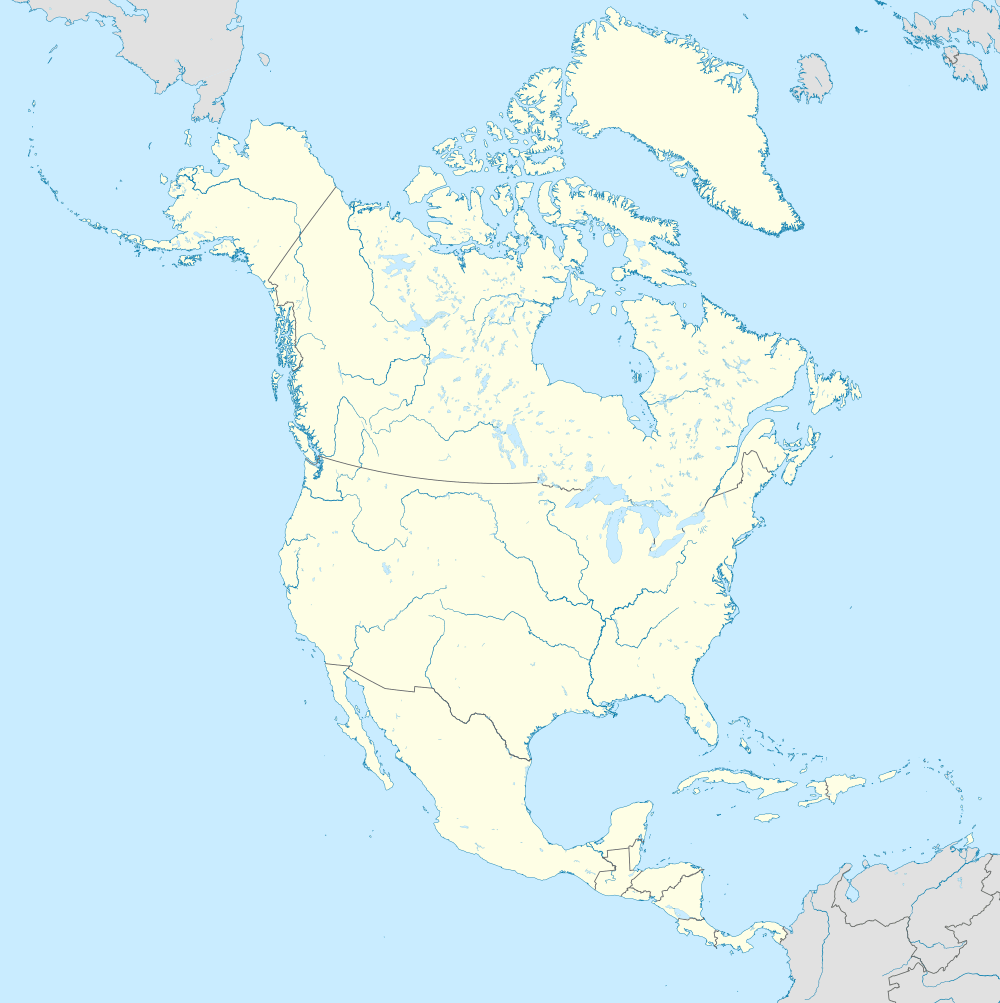New International Airport for Mexico City
| Mexico City New International Airport Nuevo Aeropuerto Internacional de la Ciudad de México (NAICM) | |||||||||||||||||||||||||||||||
|---|---|---|---|---|---|---|---|---|---|---|---|---|---|---|---|---|---|---|---|---|---|---|---|---|---|---|---|---|---|---|---|
 Aerial view of the new airport site, August 2017 | |||||||||||||||||||||||||||||||
| Summary | |||||||||||||||||||||||||||||||
| Serves | Mexico City | ||||||||||||||||||||||||||||||
| Location | Zona Federal del Lago de Texcoco, municipalities of Ecatepec, Atenco and Texcoco, State of Mexico, Greater Mexico City | ||||||||||||||||||||||||||||||
| Opened | October 20, 2020 (planned) | ||||||||||||||||||||||||||||||
| Hub for |
| ||||||||||||||||||||||||||||||
| Coordinates | 19°30′00″N 98°59′51″W / 19.5°N 98.9975°WCoordinates: 19°30′00″N 98°59′51″W / 19.5°N 98.9975°W | ||||||||||||||||||||||||||||||
| Map | |||||||||||||||||||||||||||||||
 MEX/MMMX  MEX/MMMX  MEX/MMMX | |||||||||||||||||||||||||||||||
| Runways | |||||||||||||||||||||||||||||||
| |||||||||||||||||||||||||||||||
Mexico City's New International Airport (NAICM) was announced in the State of the Union address of Mexican president Enrique Peña Nieto on September 2, 2014, and is the largest public infrastructure work in Mexico in a century. The new airport will replace current Benito Juárez International Airport, the busiest airport in Latin America transporting 41.7 million passengers in 2016.[1]
The development of NAICM is planned in four stages. Phase I, scheduled to open by October 20, 2020, will consist of one main terminal of 8,000,000 square feet (743,000 m2) and three independent runways, which would yield a capacity for 68 million passengers annually. In its final Phase (2065), NAICM will consist of six runways, an additional main terminal and two satellite terminals, with capacity for 125 million passengers, making it the second largest airport in the world today.[2]
The Master Plan has been developed by the global engineering and consultancy company Arup Group Limited.[3][4] The architectural project was designed in collaboration between Pritzker award architect Norman Foster - whose works include Beijing Capital International Airport, Hong Kong International Airport - and renowned Mexican Architect Fernando Romero - whose works include Soumaya Museum.
NAICM construction is already in process since 2016, and is managed by Grupo Aeroportuario de la Ciudad de México (GACM), a state-owned company fully owned by the Mexican Ministry of Transportation. GACM holds a fifty-year concession to build, develop, operate, and manage NAICM, and is also the parent company of the current airport AICM.
Location
The new airport is being built in a 4,432 hectare plot to the northeast of Mexico City, in the Zona Federal del Lago de Texcoco (a former lake bed).[2] Given the proximity to the current airport (AICM), about 3 miles away, the opening of NAICM requires the complete shutdown of AICM and the immediate transfer of operations to the new airport - similar to Hong Kong and Munich.
Costs and financing
The total funding required for the construction and initial operation of the New Airport is estimated at up to US$13.3 billion, of which approximately 60% will be contributed by the Mexican government through the use of public funds, and approximately 40% is expected to be funded from a combination of bank loans and the offering of debt securities.[5]
The private financing for the development of NAICM is structured as a securitization drawing from passenger charges at the existing airport in Mexico City (AICM) and future passenger charges of the new airport, upon commencement of operations, without recourse to the Mexican government or the airport sponsors. GACM has implemented the Mexico City Airport Trust, a special purpose trust under the laws of Mexico to execute this financing structure.[5] This collateral structure ensures that even if the project were to be canceled, the bonds would still be honored.
In September 2017, the NAICM Airport Trust successfully placed US$4 billion in private debt securities.[6] That includes US$3 billion in 30-year notes that are due in 2047 and yield 5.5 percent annual interest, plus US$1 billion in notes due 2028 that yield 3.875 percent annual interest.[7] This adds up to last year’s $2 billion bond issuance, which included a US$1 billion worth of 10-year bonds pay annual interest of 4.25% and US$1 billion worth of 30-year bonds pay annual interest of 5.5%.[8] The green bond issuance (the second by Mexico) became the largest in Latin America and the first green bond from an emerging market to receive a Green Bond Assessment grade from Moody's Investors Service.[8]
Facilities
The airport started the building process in 2015 with its starting phase. It is expected to put its first phase in operation in 2020. If completed as planned, the airport will have a passenger capacity of up to 68 million passengers and, if the master plan is completed in the following decades, up to 125 million people per year.
At its first phase, the airport will include:
- One X-shaped terminal of 743,000 m2 capable of handling 68 million passengers with 96 gate bridges and 68 remote bridges
- LEED certification
- Three runways capable of triple-simultaneous landing and taking off
- One control tower
When completed, the airport's total facilities will include:
- Two terminal buildings
- Two satellite buildings
- Six runways capable of simultaneous operation
Terminal design

Symbolism
The entrance to the terminal will feature a garden of cacti and symbols of the eagle and snake, part of the national symbol pictured on the country's Coat of Arms and flag.[9]
X Shape
The X is symbolic of the country's name, "México". An X-shape is also considered efficient to extend the number of gates. The X shape is used in the airports of Abu Dhabi, Mumbai, Nairobi, Pittsburgh, and Incheon.[10]
Roof
The roof is airy, lightweight, and made of membrane.[11]
According to Foster and Partners:[12]
With spans in excess of 100 meters, three times the span of a conventional airport, it has a monumental scale inspired by Mexican architecture and symbolism. The maximum span internally is 170 metres. The lightweight glass and steel structure and soaring vaulted roof are designed for Mexico City’s challenging soil conditions. Its unique pre-fabricated system can be constructed rapidly, without the need for scaffolding – the airport will be a showcase for Mexican innovation, built by Mexican contractors and engineers.
Sustainability
The terminal is to be sustainable, aiming for a LEED Platinum certification.[13] The project claims it is "designed to be the world’s most sustainable airport".[12]
Antecedents and protests
Because of the increasing traffic at Mexico City airport, President Vicente Fox announced the construction of a new, larger airport on 5,000 ha (12,000 acres) of land in the municipalities of Texcoco and San Salvador Atenco in 2002, roughly where the new airport is planned today. When local violent protests took place, the new airport was cancelled.[14] Prior to the 2014 announcement of the construction of the new airport, the government had purchased ejido land (agricultural land held in common by local communities), and the government now claims that it has no need to acquire additional locally held land to build the airport. Some local groups in Atenco and nearby communities differ, claiming that the federal government acquired the land through deception and strong-arming, and small-scale protests took place after the announcement.[15][16]
References
- ↑ "Estadísticas del AICM (in Spanish)". Aeropuerto Internacional de la Ciudad de México.
- 1 2 "Programa Estrategico / Institucional" (PDF). Grupo Aeroportuario de la Ciudad de Mexico (GACM).
- ↑ "Plans for a new Mexico City Airport being reviewed - Airport World Magazine". Airport-world.com. 2014-06-25. Retrieved 2015-11-12.
- ↑ Alper, Alexandra (2014-06-19). "New airport plan for Mexico City eyes six runways: sources". Reuters. Retrieved 2015-11-12.
- 1 2 Mexico City Airport Trust. "Bond Offering Memorandum" (PDF). GACM.
- ↑ "Bono verde aportará 4 mil millones de dólares para el Nuevo Aeropuerto Internacional". www.elfinanciero.com.mx. Retrieved 2017-10-02.
- ↑ "Mexico Unveils $4B More In Green Bonds To Fund New Airport - Law360". www.law360.com. Retrieved 2017-10-02.
- 1 2 "Mexico Sells $2 Billion in Green Bonds to Help Finance Airport". The Wall Street Journal. Retrieved 24 September 2016.
- ↑ Magrath, Andrea (2014-09-04). "British architect Lord Norman Foster's plans for Mexico City's new £5.5BN airport unveiled | Daily Mail Online". Dailymail.co.uk. Retrieved 2015-11-12.
- ↑ "9 puntos clave sobre el nuevo aeropuerto de la Ciudad de México - Exportaciones - Nacional - CNNMexico.com". Mexico.cnn.com. Archived from the original on 2015-11-09. Retrieved 2015-11-12.
- ↑ "Norman Foster, Romero to build Mexico airport | Reading Eagle - AP". Reading Eagle. 2014-09-03. Retrieved 2015-11-12.
- 1 2 "F+P & FR-EE Fernando Romero to collaborate". Fosterandpartners.com. Archived from the original on 2015-11-15. Retrieved 2015-11-12.
- ↑ "Mexico City's New Mega-Airport Will Collect Its Own Energy and Water". Gizmodo.com. Retrieved 2015-11-12.
- ↑ Ginger Thompson (August 3, 2002). "Mexico Drops Planned Airport After Protests From Peasants". The New York Times. Retrieved 2015-11-12.
- ↑ "Con "toma" de maquinaria, Atenco inicia protestas contra aeropuerto — La Jornada" (in Spanish). Jornada.unam.mx. Archived from the original on 2016-03-04. Retrieved 2015-11-12.
- ↑ "DF - Reactivan lucha en Atenco contra aeropuerto". El Universal. Retrieved 2015-11-12.
External links
- "NAICM official website" (in Spanish).
- FR-EE's presentation
- Video at Foster + Partners website
- Airport site map on "Aeropuerto de la ciudad de México: aterriza proyecto" [Mexico City airport: project lands]. El Economista (in Spanish). 2014-09-02.